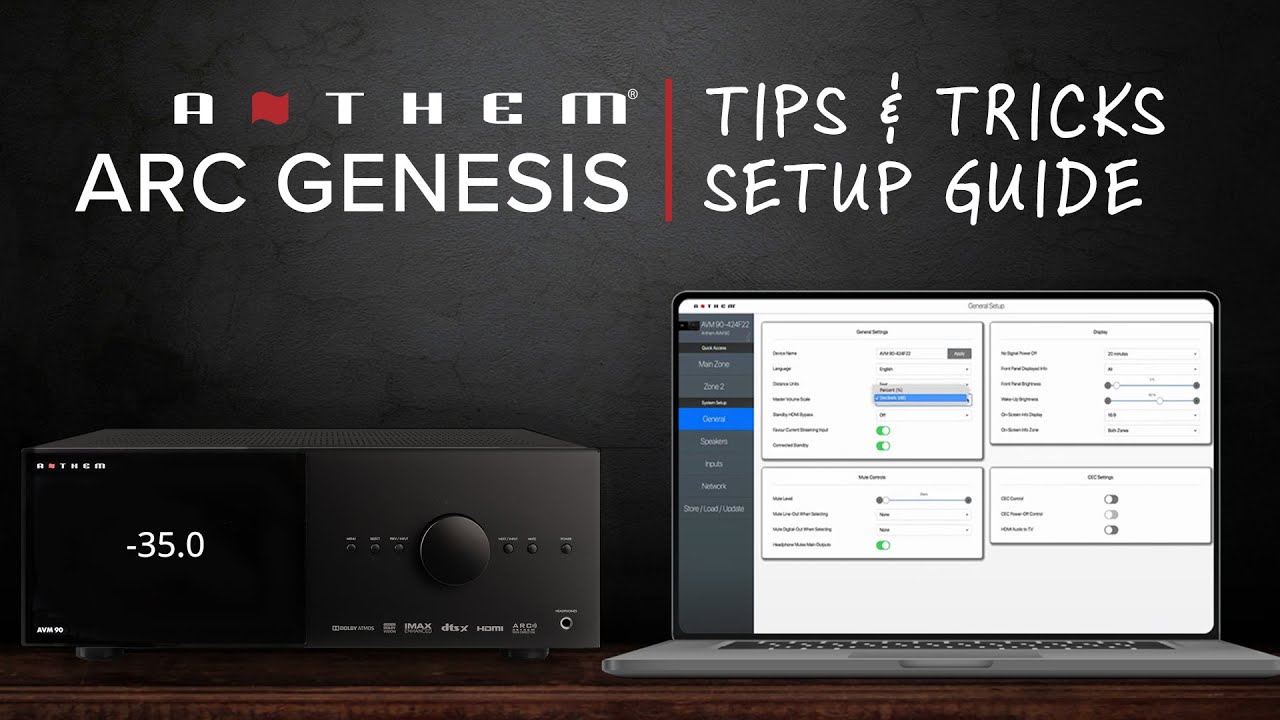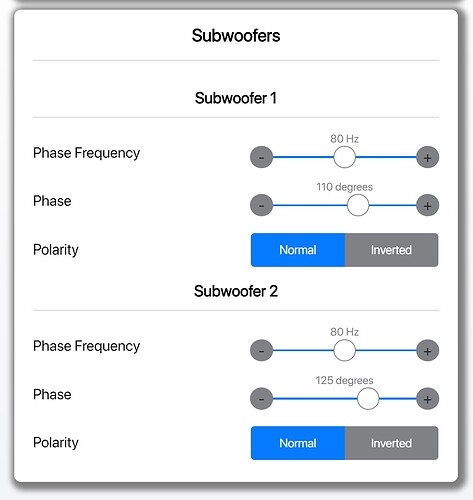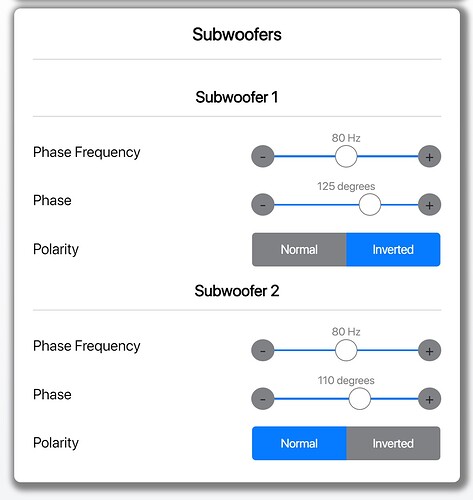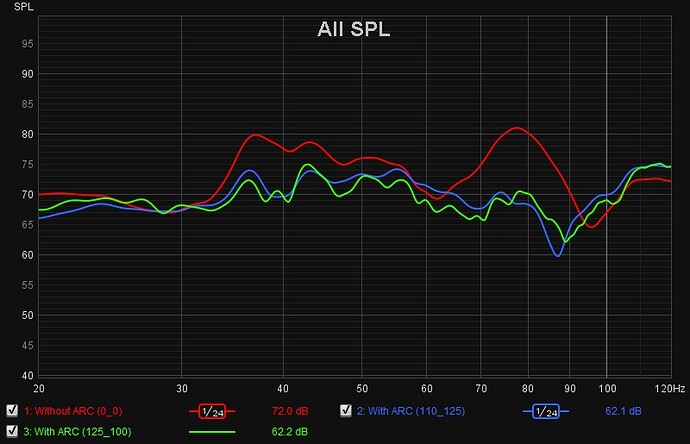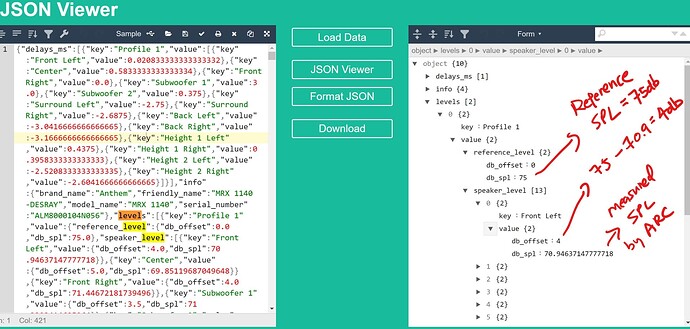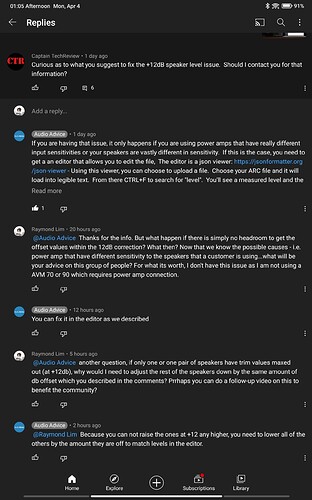Anthem ARC Genesis Setup Guide // Tips & Tricks for Anthem Surround Sound Processors & Receivers - YouTube
How’d you get the new firmware… mine still at .160
Go to your Web UI and check for update first. Then go to your AVM70 and check for update to ensure that it is updating. If all goes well, check the Web UI by refreshing the page and ensure the new firmware is updated.
Frankly, after watching this so called tips on ARC calibration, it got me worried for those with exceptionally high trim values for your speakers like the ones shown in the video. Anything at 12dB correction is worrying as that’s the highest ARC can go during the calibration even though the chap reassures you that everything is fine and that he has a solution (but choose not to show it) is quite revealing. There are a few AVSForum members facing this issue. Sure I also know the “workaround” that he is implying but this is something I would say, “out of the norm” and it shouldn’t need to be done by normal user.
Fortunately in my case, I didn’t face this issue but I would really want to investigate this “high trim value bug”. If any member here face a high trim value of say 10dB or worse 12dB despite several attempts in calibration. Pls let me know and I would like to pay you a visit and do a little experiment. I am trying to find out is it due to the room layout, the speaker placement, the sensitivity of the different stock mic or the way you do your calibration that is wrong.
I truly hope Anthem is working on a solution as this shouldn’t be happening.
Tried all that, still does not update past 108.160
That’s odd… This is the only way to do it and I can’t think of any other way. Sorry.
After a few attempts it seemed to have worked.
Bro u using AVM 70?
Web UI firmware and BETA selected showing green?
Ya @desray above instructions Was exactly what I did.
Thanks.
Cool ![]() think need to d a refresh of the web UI
think need to d a refresh of the web UI
Another way is to check the Info setting on the AVM70 to confirm that the firmware (referring to the network module) has been updated.
Just how accurate is auto phase calibration in ARC? Let’s find out…
Finally, spent some time to do a REW measurement today and I have an observation that I will like to share. The most important question everyone wants to know is how accurate is ARC’s auto phase calibration? Unfortunately, it is a mixed bag for now. YES it works and NO it can get it wrong occasionally. Huh?! Shocking?!
It works but…
ARC’s auto phase calibration does get the job done for the most part. However, ARC does have the tendency to screw up the polarity of the subwoofers for users with 2 or more subwoofers. So how do we know if the auto phase gets it right? Well, there are a few distinct characteristics right off the bat. First, you will immediately hear a distinct separation of bass that is clean, tight and punchy. It has a “stereo bass” feel to it. The bass will not drown out the surround sounds and the dialogue is clear. In gist, the bass sounded super “clean”. You will know you got it right when you “hear and feel” it.
The not so good part is it does screw up the subwoofer polarity occasionally, Again, you will hear and feel it when the bass becomes “dull” and sounded “one-note” or simply lack spatial effects. If this is the case, then you can try selecting “Invert” aka reverse polarity on the subwoofer using the Web UI. Hear and feel if there is any difference.
Here’s what I have found using the REW. Take a look at the pic below:
Default phase value (BOTH subwoofers at “Normal” or 0 degree polarity)
Inverted phase value (FRONT pair of subwoofers switched to “Invert” or 180 degree polarity)
Here’s the REW readings
- Red line depicts “No ARC” has been applied.
- Light blue line depicts the default phase value for Subwoofer 1 (one pair of JL Audio E112) at 110 degree and Subwoofer 2 (one JL Audio E110) at 125 degree. Notice the dip at around 87Hz but otherwise the reading is pretty flat from 80Hz and below.
- Green line depicts the inverted phase value for Subwoofer 1. I notice that when you select an inverted polarity, you will need to switch the phase values for Subwoofer 1 and 2 - i.e. Apply 125 degree for Subwoofer 1 (Invert polarity) and 110 degree for Subwoofer 2 (Normal polarity). Now notice how the response curve (green line) for the 3 subwoofers combined becomes more flat.
Conclusion
ARC:G auto phase calibration does a fantastic job to achieve a flat response while time align the subwoofers but occasionally it will screw up the polarity bit. My advice for those who hear or feel the bass doesn’t sound “right” after the auto phase correction, I will advise you to re-do the phase calibration again and there is a high chance that ARC will get it right after a few tries. Do vary your mic’s position a little to get different results and hopefully ARC will get the phase polarity right this time. For those who has a REW and a Umik 1 lying around and wish to experiment for yourself by taking objective readings, you can do that.
For the most part, I will say that the auto phase feature worked splendidly except for a few occasions that requires you to do the polarity switch trick to get it right.
Here’s a JSON parser and viewer for those who are interested to take a look at how ARC computes the offset dB values aka trim values for each of your speakers and subwoofers.
GO here: Best JSON Viewer Online (jsonformatter.org)
Upload your anthem.arc file and choose JSON viewer. A tree view will display the various Profile along with its speaker dB_offset values which is simply (Reference SPL - Measured SPL = offset dB). For those with high trim values that has a +12dB trim value, you can see what is the measured SPL. You can use that to calculate the actual dB_offset value for each of your speakers and subwoofers. Use this for troubleshooting if you want.
Saw on today AVSforum AVM 70/90 thread some AVM 90 owners encountered issues with test tones and etc, but after a reset of the AVP - most of them fix the issues ( below is the issue)
Therefore i will always recommend a reset of the AVP after a fresh firmware upgrade and recalibrate with the new ARC Genesis version.
Yes, in situation like this…
This is what I will always do. Whenever I get in the equipment with a firmware update, I have the habit to reset everything to factory default before I start any calibration, if recalibration is required. Otherwise, I’ll just update it without any factory reset
yes, this is a good habit, I encountered multiple critical errors during last Sat night calibration. I upgraded to 1.6.4 Genesis software and re-calibrated the system, in the beginning and between the process I encountered not just critical errors, but also high noise floor errors. I re-tried on Sunday, with factory reset, whole calibration is very smooth without any errors.
Trust me, all of us will encounter such an error from time to time especially after prolonged period of calibration. I have been playing with it longer than anyone here to know the idiosyncrasies of this device. But I do agree that if you’ve encountered some odd issues along the way that prevents you from using the device the way it should, then reset to factory default is the way to go but not for every firmware update.
A follow up questions on the high trim values issues to Audio Advice since they are rather responsive in the YouTube comment section. Not really a perfect solution but it does make sense.
Hopefully no one here need to resort to this method.
I had this issue, got two height speakers at +12dB and checked editor, they are really measured at ~63dB so +12dB is actually correct on the other hand, i always do level measurement/alignment for all channels after ARC (i like to set 75dB @-20dB every time, for example), so thats not a big deal for me anyway
Another review of the AVM 90 Flagship. ![]()
